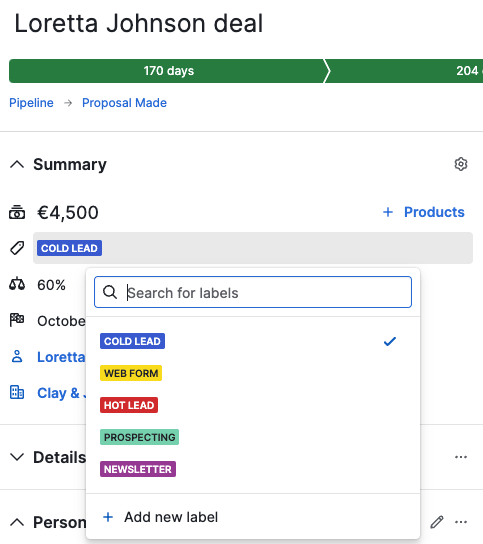Sales mirroring can turn awkward meetings into fluid conversations. Matching your customer’s communication style makes them feel understood, creating instant rapport that builds trust.
In this article, you’ll learn mirroring sales techniques across different channels. We’ll provide a framework you can follow to develop a natural approach that feels authentic to you and your prospects.
What is sales mirroring?
Sales mirroring is a technique in which salespeople adapt their communication style to match or “mirror” their prospect. When done authentically, mirroring shows prospective clients you’re listening to them and trying to understand their issues, which creates trust and builds rapport.
Genuine mirroring isn’t about manipulating prospects or copying them. Instead, your goal is to be genuine in your intent when you match their communication style. When mirroring feels forced or insincere, it often backfires and damages trust.
Mirroring in sales can be both instinctive and deliberate. Some salespeople are naturally charismatic and mirror prospects without thinking about it. For other professionals, it’s a sales skill they develop consciously.
Communication happens through three main channels: words, tone of voice and body language. While each channel matters in sales conversations, its importance varies depending on context and situation.
Here are the key elements of mirroring in detail:
Elements of mirroring | Explanation |
Words | Adapting your vocabulary and language to match your prospects. For example, in sales meetings, you can match industry terminology. Customers feel understood because they don’t need to explain basic terms. |
Tone of voice | Matching your prospect’s speaking pace, volume and vocal energy. Prospects feel more at ease when you match their natural speed. Fast talkers don’t feel slowed down. Slow talkers don’t feel rushed. |
Body language | Reflect your prospect’s nonverbal cues and communication style, such as posture, mannerisms and facial expressions. Mirroring customers’ body language creates a sense of familiarity and comfort. |
These aspects of mirroring can significantly impact your sales communication, and we’ll share tips for leveraging each later in the article.
Why sales mirroring is important
Effective sales mirroring can lead to shorter sales cycles and higher close deal rates. As sales prospects feel heard rather than sold to, you create stronger customer relationships that boost sales over time.
Sales mirroring aligns with value-based selling. While traditional selling focuses on features, value-based selling is about understanding customer needs. It focuses on understanding customer needs and communicating in a way that resonates with them.
According to Pipedrive’s state of sales and marketing, 36% of sales professionals believe value-based selling will impact sales strategies in the future.

When you mirror your prospects, you create comfort that encourages them to share more. They reveal pain points, priorities and objectives they might otherwise keep hidden. Matching their communication style helps you sell based on their needs, not your products.
Sales mirroring techniques for different situations
In-person meetings allow you to mirror prospects across words, tone and body language. However, sales mirroring can be challenging when you can’t see your prospect face-to-face.
Each communication channel offers different opportunities. The right mirroring approach will help you connect with prospects, regardless of circumstances or your communication style. Here’s how to use sales mirroring for different channels.
In-person meetings
Face-to-face meetings provide the best sales opportunity to apply mirroring techniques. You can use all the dimensions of mirroring (e.g., voice, tone and body language).
Body language is most relevant for in-person meetings. You can notice and respond to physical cues that aren’t visible in other channels.
Here are some key strategies for in-person mirroring:
Match posture. If your prospect sits with their back straight and hands on the table (formal), adopt a similar posture. For prospects with legs stretched and arms spread wide (casual), mirror this relaxed position. Wait several seconds before mirroring these gestures. If you do it instantly, it can appear insincere and forced.
Use industry terminology. Listen for technical terms or jargon your prospect uses, especially when discussing pain points. Weave these terms naturally into your responses without overusing them.
Adapt the speaking pace. If your prospect speaks quickly and enthusiastically, increase your energy. For methodical prospects, slow down and incorporate strategic pauses after key points.
Reflect gestures. Notice the hand movements your prospect uses when making important points. Incorporate similar (but not identical) movements when speaking.
Mirror eye contact patterns. Pay attention to how your prospect uses eye contact. If they maintain steady eye contact, do the same. If they periodically glance away during conversation, incorporate similar patterns.
Notice how your mirroring changes throughout longer in-person meetings. Comfort levels increase as conversations develop. Your mirroring should become less conscious and more fluid.
Video calls
You can still use all types of mirroring in video meetings – with limitations. Prospects can only see your face and upper body, so you’ll have to emphasize your facial expressions and upper body language while relying heavily on words and tone.
According to McKinsey, in 2021, approximately two-thirds of buyers preferred remote human interactions or digital self-service. Since buyers prefer virtual meetings over face-to-face interactions, the shift toward digital selling has become the new standard.

Mirroring techniques can help you stand out in on-screen sales conversations.
Here are some strategies for video call mirroring:
Focus on upper body language |
|
Match digital behaviors |
|
Mirror vocal patterns |
|
Video calls need stronger mirroring than in-person meetings. The screen creates distance, so your matching needs to be more noticeable while still feeling natural.
Phone conversations
During phone calls, you miss the visual cues completely. You’ll have to rely on words and tone mirroring without visual feedback.
There’s a gap between what sales reps think they’re delivering and what customers experience. In fact, 62% of sales reps say they listen to prospects’ needs, but 83% of buyers with negative experiences say this wasn’t their experience.

In light of this discrepancy, your word choice and ability to show customers you’re listening become especially important on the phone.
For example, you might think you’re actively listening to how a prospect describes their challenge. You might nod along with what they’re saying (which the prospect can’t see). However, when you immediately move to pitching the solution, the prospect feels unheard.
Instead, you want to show you understand their specific situation. Start by repeating or rephrasing what you heard.
Former FBI negotiator Chris Voss explains that his mirroring technique is simpler than most people think:
Here are a few ideas for strengthening mirroring techniques on the phone:
Take notes of your prospect’s vocabulary and communication style.
How do they transition between topics? Use similar transition phrases.
How do they typically greet you on calls? Mirror their greeting style.
Do they prefer getting straight to business or starting with small talk? Follow their conversation structure.
For tone, focus on your pace, volume and energy. Phone mirroring techniques rely not only on what you say but also on how you say it.
Mirror their speech patterns and use of emphasis. Do they emphasize through volume, elongating words or pitch changes? Also, track their energy levels throughout the call and follow a similar pattern.
Email and written communications
Written communication may be one of the easiest ways to mirror. Unlike in-person meetings, video and phone calls, you don’t have the pressure of instant back-and-forth. You can take your time to plan the best way to respond to your prospect.
For this, note the other person’s writing style (e.g., professional, casual, humorous) and mirror it appropriately. You don’t want to be overly professional when your prospect sends you a friendly email.
Match their level of personal vs. professional content. Some people include personal touches in their emails, while others stay on business topics. Mirror their use of humor, analogies, metaphors or even emojis (if appropriate).
Also, pay attention to communication patterns beyond the message itself. Use your sales calendar to track when specific customers typically respond and adjust your timing to match. For instance:
If they respond to emails immediately, prioritize quicker replies
If they take their time to respond, allow for similar delays between messages
You don’t want your prospect to feel like you’re making them wait or pressuring them to reply.
Note: Regardless of the other person’s patterns, it’s typically considered good email etiquette to respond within 24–48 hours.
If it’s your first time contacting a prospect, you may be unsure of their writing style. In this case, start with a formal yet friendly approach. When they reply, match their communication style.
Common sales mirroring mistakes to avoid
Sometimes, sales mirroring can damage rapport-building. Misapplied techniques can seem manipulative or awkward, creating distrust at critical points in the customer journey.
Here are some common mistakes to avoid when using mirroring techniques in sales.
Mirroring too obviously
Copying your prospect’s body language and behaviors immediately and exactly can feel unnatural. Instead, you should subtly mirror their behavior with slight delays.
Even though the concept of mirroring is self-explanatory, you don’t want to do it to the last detail. Prospects notice when you mirror them too obviously and become uncomfortable.
Mirroring inappropriate language or behaviors
Certain behaviors can damage your professional image and credibility. While sales mirroring aims to build a connection, you must maintain professional standards. You should avoid mirroring:
Profanities
Politically charged stances or terms
Inappropriate jokes
Also, avoid mirroring negative body language, such as crossed arms or impatient gestures, that will make you come off as defensive or frustrated.
Trying to mirror too many elements at once
Focus on mirroring one or two aspects of communication at a time. Attempting to mirror every word, tone or gesture feels mechanical and divides your attention.
Begin with simple elements, such as speaking pace and energy levels. When you’ve made progress on these, change to more complex mirroring tactics.
Download Your Guide to Preventing 5 Common Sales Mistakes
5 steps to practice sales mirroring
While mirroring should be natural and authentic, it may require practice. You can’t control every signal you send, and much of body language is unconscious.
The harder you try to manage every aspect of your communication, the more unnatural you’ll appear. However, that doesn’t mean you can’t practice and improve your mirroring skills.
The following framework will help you develop your mirroring skills until they become second nature. Use them to learn how to apply these techniques in low-risk environments before applying them with real prospects.
Step 1: start with observation
Before copying gestures or repeating words, develop your observation skills through active listening. Notice not only what people say and do, but also the patterns in their communication style.
What to observe:
Topic-based shifts. Notice how their style changes between subjects. Some prospects speak slowly about technical details but speed up during small talk.
Dominant communication elements. Identify if they communicate through words, tone or body language more often. Some prospects barely move but use precise language. Others gesture a lot but speak more generally.
Verbal patterns. Listen for phrases they repeat, industry jargon or transition words they favor (“essentially”, “fundamentally”, “the thing is”).
Practice exercise: Have lunch with colleagues and focus on observing, not mirroring. Check for two or three communication patterns in one person. For example, one of your colleagues could speak at a measured pace and gesture with open palms.
Step 2: practice with colleagues
Unnatural mirroring in customer interactions could cost sales. Practicing with colleagues allows you to experiment and refine your techniques.
The feedback will help you identify what feels natural versus what looks forced. Possible practice exercises include:
Role-play of sales scenarios
Record practice sessions (with permission) to review your mirroring
Mirror exaggerated styles to make patterns easier to identify
Take turns being the mirror and the observed
Partner exercise: In pairs, have one person tell a work story while the other practices mirroring just one element (e.g., speaking pace, posture, energy levels). Once finished, switch roles and focus on a different element. Discuss what felt natural and what seemed forced.
Step 3: apply one technique at a time
Don’t try to mirror everything at once, which can lead to awkward and mechanical interactions. Instead, start by developing one technique before combining them.
Here’s how you can build your skills progressively:
Week 1 – Focus on matching the speaking pace
Week 2 – Add vocabulary mirroring while maintaining pace-matching
Week 3 – Incorporate basic postural mirroring
Week 4 – Include tone and energy matching
Practice exercise: Apply your focus technique in low-stakes customer interactions, such as casual sales demos, initial sales pitches or discovery calls.
Step 4: gather feedback
Without feedback, it’s difficult to know if your practice sessions are working. Here are a few ways to get some insights into how you’re doing:
If a trusted colleague is joining you on a customer call, ask them to observe your interactions and provide feedback.
If you record sales calls, review the recordings to see whether your communication style matches your prospect’s.
Do your efforts seem forced or natural?
Are there any specific improvements you should apply?
Did your customer feel understood or uncomfortable?
Take notes about the technique applied, the prospect’s reaction and your comfort level. Documenting will help you understand what worked and what didn’t rather than relying on memory.
Step 5: refine and personalize
Effective mirroring feels authentic because it aligns with your natural style. The final step is adapting techniques to fit your personality and strengths as part of your sales strategy.
First, identify which mirroring techniques feel most natural to you. A good way to understand this is to notice the type of prospects with whom you connect easily. Common prospect types include:
Analytical types. Those who communicate with precision and focus on details. They speak methodically with minimal gestures and an even vocal tone.
Expressive types. Those who communicate with enthusiasm and focus on the big picture. They speak quickly and use frequent gestures and facial expressions.
Driver types. Those who communicate directly and focus on efficiency. They have a strong posture, use some gestures and prefer brief conversations.
Amicable types. Those who communicate warmly and focus on relationship building. They speak in a friendly way and display open body language.
Once you’ve identified which you naturally connect with and which require more conscious effort to mirror, create specialized approaches for challenging personality types.
Want to Learn How to Influence Your Prospect’s Buying Decisions?
How to use Pipedrive to refine your sales mirroring
You can use Pipedrive’s CRM as a customer data platform to document, analyze and improve your sales mirroring over time. Effective sales reps document sales activities and customer patterns to build stronger relationships.
Documenting customer communication preferences
With Pipedrive’s labels and notes, you can record your prospect’s communication patterns. Create labels or custom fields for communication style preferences like:
Speaking pace (e.g., fast, medium, slow)
Formality level (e.g., casual, moderate, formal)
Preferred communication channel (e.g., phone, video, email)
After each interaction, update these fields based on your observations.

In the notes section of your lead details, you can describe the contact’s communication style or body language. These notes can help you and other sales team members with future interactions.
Planning before important calls
Before important sales calls, review your Pipedrive notes on the prospect’s communication preferences. Create call scripts or talking points that incorporate words or phrases they commonly use.

After a sales conversation, update your Pipedrive records accordingly. Note which mirroring techniques were effective. Be specific about what worked well and what got negative feedback.
Note: You can also create email templates matching contacts’ communication styles, mirroring their greeting and closing preferences. You can even use workflow automations to schedule emails to match their response cadence.
Analyzing patterns in successful conversations
Sales reporting features allow you to spot patterns in your successful deals. Create labels for different mirroring techniques or for specific communication styles.

Review your sales data from successful sales and analyze their similarities. You can identify which approaches work best with different prospect types from your notes.
Did prospects who preferred direct communication close more quickly? Did technical buyers respond better to detailed explanations? The patterns help refine your mirroring strategy for prospects with similar profiles.
Final thoughts
Sales mirroring transforms awkward conversations into meaningful connections. By matching your prospect’s communication style, you create trust that leads to stronger sales relationships.
Start with careful observation, focus on one technique at a time and practice in low-risk situations. Document what works in Pipedrive to build a personalized mirroring approach that feels natural to you and your prospects.
Sign up for a free trial to see how Pipedrive can help you track communication preferences and develop mirroring skills that close more deals.






